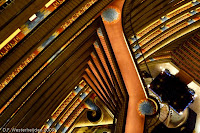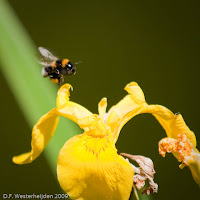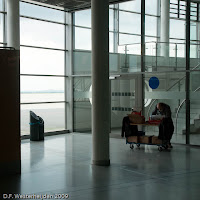
Conventional wisdom has it that photos of patterns and structures are prime targets for black-and-white. The dandelion of this week's blog was precisely such an object, I thought when taking the picture, but when I saw it on the computer screen, I did not change it from its original colours. The brownish, unfocused background adds something to it. Without this collective of seed ends in their original colour, I found the photo too abstract, too much shouting out that it wanted to be an artistic photo rather than a real picture of a flower. Now, with colours, I think its artistic value is more subdued--and heightened by that very fact. It now is a photo with two layers of meaning (at least): the seedhead itself and the pattern of star-form lines.
At a third level of meaning--if you want to go that far--the colour photo is a symbol of the transience of life, precisely because it refers more clearly than the black-and-white version to the seedhead itself. For the seedhead is destined to let go of the seeds at the first wisp of wind, of course.

The second photo here was not quite as good as the first one (in my eyes) for technical reasons: it lacks depth-of-field in the centre. But it help illustrate the point: this one, although also a close-up and also playing with the star-form patterns, is obviously a dandelion even in black-and-white and does not lose its layers of meaning by the reduction of colour to black-and-white.
By the way, you can see I am influenced by having begun to read a book I just bought: Jeffrey, Ian. 2008.
How to Read a Photograph: Understanding, Interpreting and Enjoying the Great Photographers. London: Thames & Hudson. He finds so much more meaning in "simple" pictures, that you almost start to think your own photos have meaning(s), too ;-)
 Little to say, but more to see in this amazing hotel I am visiting, the Marriott in Atlanta, Georgia. The atrium, stretching from bottom level to 50 floors up, almost defies taking into a single photo, and yet it is full of architectural motives, with the curves and not-quite-repetitions of positions of concourses and bridges.
Little to say, but more to see in this amazing hotel I am visiting, the Marriott in Atlanta, Georgia. The atrium, stretching from bottom level to 50 floors up, almost defies taking into a single photo, and yet it is full of architectural motives, with the curves and not-quite-repetitions of positions of concourses and bridges.  It all reminds me of a genteel version of Zion in the movie trilogy The Matrix. Even worse: aren't those closed doors and uninhabited galleries just like a prison? And another advantage of Zion over the hotel: it did not have such tacky colours in the carpets on the floors ;-)
It all reminds me of a genteel version of Zion in the movie trilogy The Matrix. Even worse: aren't those closed doors and uninhabited galleries just like a prison? And another advantage of Zion over the hotel: it did not have such tacky colours in the carpets on the floors ;-)




.jpg)

